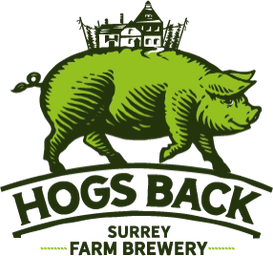April in the Hop Garden
Welcome to April’s update from a Year in the Life of our Hop Garden.
Spring is definitely here! The recent warm weather has seen the rape seed field adjoining the hop garden slowly turning into a bright blaze of yellow. The birds are singing and all is calm in the hop garden.

After three weeks of non-stop stringing, Matthew has just reached the halfway stage! That’s 43 alleys fully strung....

....and only half a pallet of coconut coir left!

It’s very soothing watching the rhythmical process of stringing. There is a real art to it, as Matthew needs to make sure that when it comes to harvesting, the tractor can go down the alley with the Hoppers cutting and pulling the bines on their right.

The process is the same for each hop plant. Matthew starts by attaching the coconut coir to the top left hook on the top wire, before bringing the string to the peg. This first string is called a “stock”. Then from the peg, it’s up to the next hook on the left hand side as a “half stock”, back down to the peg, and across to the top right hook with another “half stock”, back to the peg, before another full “stock” to the next peg on the right, so he is positioned ready for the next hop plant. In this way, he will work his way downhill, from one side of the hop garden to the other.

With the hop plants 6 ft apart and the hooks on the high wire set at 2ft intervals, an elaborate pattern of stringing emerges.

It’s quite a feat to reach the hooks on the top wire, as it is 16ft up in the air. The old hop garden wire was only 14 ft due to the overhead electricity cables, but 16 ft is the traditional height for a hop garden. The technology for stringing is not very sophisticated – just an 8 ft pole with a hook on it!

But at least it is a lot safer than stringing in the olden days, when stilts would have been used!

Individual string would have been tied to the high wire and then fixed to the pegs in the ground. Coir has been imported for a couple of centuries but before that probably hemp or hessian would have been used.
Getting the tension right on the strings is an art in itself. The closer to the poles, the tauter the high wire, so as Matthew goes down the rows, the tension changes so you see “peaks” and “troughs”.

The stringing is one continuous piece of work. When Matthew gets to the end of one of the coils of coconut coir, he simply ties the new bale on with a reef knot.

Matthew is hoping to finish stringing the Fuggles early next week, before he moves onto the Farnham White Bine. The Farnham White Bines have really come on very fast, using all the energy from their own rootstock, as not all the hops were harvested at the very end of the 2021 harvest. He'll then move onto Cascade and aims to finish stringing by the end of May. He’ll need to hurry. The warm weather means the hops have put on a spurt of growth over Easter.

With no April frosts to check the growth, the purple shoots that were just poking through the soil, have been transformed into burgeoning hop plants, each putting out up to 100 shoots, with their “asparagus” shaped head and distinctive leaves.

It will soon be time for Matthew and the team of Hoppers to cut back by hand all the bines that are too high, as they won't produce a good crop, as well as those bines whose stems are too thick, also known as a "rank" bine. He and the team will then start “twiddling” or “twizzling”, which means training 2 shoots up each of the four strings per hop plant. Some of the tenacious shoots are already attaching themselves!

Chef Ben is already working on some ideas for Poor Man’s Asparagus recipes, featuring the shoots, which resemble asparagus in looks, but less so in taste! The younger the shoots, the better, when it comes to eating, as tiny little barbs start to develop on the bines, which help them grab onto the strings to climb. Look out for these recipes on the Tap menu!

Despite the stringing, there is still some maintenance to be done on the garden. Some of last year’s old hop bines are being burnt to avoid any infection.

If you would like to help with the twiddling as a volunteer in the hop garden over the next couple of weeks, why not become a Hopper? Pop your details down and we'll get back to you with all the details. Some of the working sessions will be during the week, but Matthew is hoping to organise some Saturday sessions as well. Or come on one of our guided Hop Garden tours in July and August when the hops are looking their glorious best.

Finally, we’re pleased that Rev. Claire Holt from St Paul’s Church in Tongham, will once again be blessing the hops on Thursday 26th May. Book your free place to join us for this traditional ceremony, which takes place on Ascension Day, and toast a successful harvest with a complimentary pint of beer.
For all the latest news and updates from the Hogs Back Brewery, sign up to our newsletter below and follow us @HogsBackBrewery on Twitter, Facebook and Instagram.

